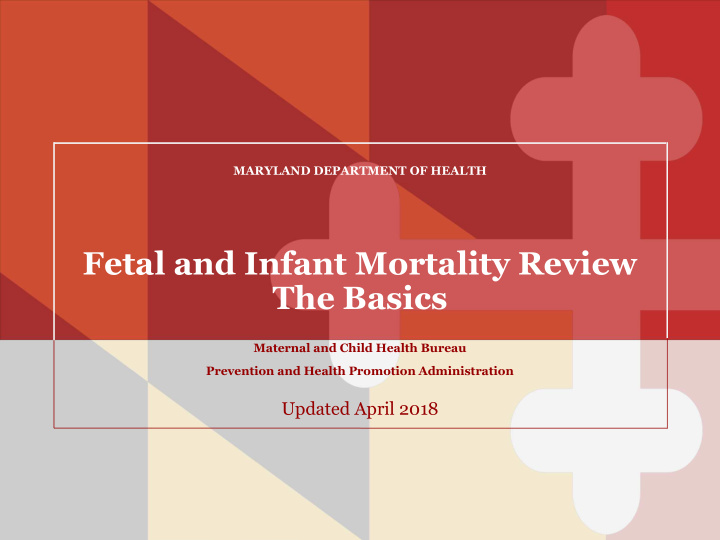



MARYLAND DEPARTMENT OF HEALTH Fetal and Infant Mortality Review The Basics Maternal and Child Health Bureau Prevention and Health Promotion Administration Updated April 2018
Overview of FIMR Program • What is FIMR? “A community commitment to improved pregnancy outcomes” • Focuses on systems of care and identifying gaps in care resulting in action • Aims to improve pregnancy outcomes- enhances existing perinatal care system’s goals • Community-based • Adds family voice
Overview of MD FIMR Program • Goal: Improved health and well-being of families in Maryland. • Every death is a tragedy for the individual, family and community. • Public Health Approach: • Surveillance — Monitor sentinel events to identify systems failures. • Quality Assurance — Investigate events to develop strategies for prevention.
Core Public Health Functions • Assessment: collection and analysis of data related to the health of the community. • Policy development: through appropriate use of assessment data. • Assurance: access to services, programs, and policies to sustain health.
What FIMR Is…What FIMR Is Not • Is focused on systems issues rather than seeking redress. • Is not peer review or medical case review. • Is used to understand the how and why of poor outcomes. • Is not for assigning blame to either patients or providers.
Review of FIMR Process • Tracking • Identify sentinel events. • Review • Collect information from various sources. • Review selected cases with multi-disciplinary team. • Develop recommendations. • Action • Develop plan for community action. • Mobilize community for action.
Tracking Cases • To document number of deaths or cases received. • To identify key trends or issues of interest. • To determine priorities for case review.
Case Tracking Steps • Process • Notification of sentinel event. • Log in case and assign case number in spreadsheet or table. • Enter key characteristics. • Establish timeline for reviewing cases entered to date to identify any key trends or issues of concern. • Share with CRT/other key personnel to determine priorities for case review.
Case Review Process • Gather information • Tell the story • Analyze the interaction between systems of care • Identify possible needs or problems • Synthesize all case findings • Recommend policy or system changes
Key Guidelines for Case Review • All case material is de-identified. • All material is held in confidence. • Make every effort to understand mother’s perspective of events. • Understand circumstances of individual case to develop recommendations to improve systems of care for everyone.
Planning for Action • Essential to achieving systems change. • Ensures that scarce resources are focused for the most effective results. • Documentation of efforts and accomplishments validates the investment in activities.
Recommend
More recommend